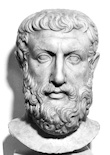|
One who sees non-action (akarma) in action (karma) and action in non-action, Śaṅkara comments: [The expression] “in action” refers to the acting (karma), and therefore to what is performed (kryate), and thus to any act of an empirical order (vyāpāra). Since both activity (pravṛtti) and non-activity (nivṛtti) are related to an acting subject and, truly, any cognition regarding action, agent, and so forth, is possible only based on ignorance (avidyā), that is until Reality (vastu) has not been comprehended, [it is said:] “One who in action sees non-action”, absence of action, and one who “in non-action...”, in absence of action sees, perceives “... action, he is wisest among men, he is a” yogin, one “who has realized the yoga, who has fulfilled everything”, who has carried out action in its totality. Therefore praise is paid to one who sees action in non-action and vice-versa. Objection: When it is said that “One who sees non-action in action and, action in non-action” it is contradictory: in fact action cannot be non-action, nor non-action action. If it was so, how could the witness (draṣṭṛ) perceive such a contradiction? Answer: Not so. In reality to the empirical vision of the ordinary person, subjected to ignorance, non-action itself appears as action and, similarly, action itself as non-action. In this regard, with an aim to teach [their] nature as it is, the Lord [says]: “One who in action sees non-action...” So there is no contradiction, both because the nature of wisdom is admitted, etc. [for one who sees in this manner], and because, where it is [repeatedly] said that “it is necessary to learn (boddhavyam)” (IV, 17) [regarding action and non-action, the Lord] intends to propound [their nature] as they are. It has been said that: “... in comprehending this you will be freed from error” (IV, 16), and the emancipation from impurity cannot take place through erroneous knowledge. Therefore both action and non-action are comprehended erroneously by the living beings, and in order to dispel their false conception, the Lord expresses himself in terms of: “One who in action sees non action...”, and so on. Furthermore non-action cannot [literally] be contained in action or be placed in it as a piece of fruit of badara in a container, nor action can be contained [literally] in non-action, since non-action is absence of action. Therefore action and non-action are interpreted by ordinary people in a totally erroneous manner, as water is [apparently perceived] in a mirage or silver in the mother-of-pearl. Objection: Nevertheless action is the same for everyone, and in no way will it be [perceived] any other way. Answer: No, not at all, because one can establish that when a ship is moving, to the man on the ship the trees, which are on the shore, seem to be moving in the opposite direction, while, on the other hand, that, although they are moving, an [apparent] absence of movement is perceived of objects which are distant and are far from the eyes. So also in this case, the perception of action in non-action and the perception of non-action in action constitute an erroneous knowledge, for which to be removed it is said: “One who in action sees non-action...”, and so on. Although the answer has been given to this objection [of yours] more than once, those who have been subjected for a long time to an erroneous conviction and continue to be confused, and forget the truth, no matter that they heard it repeatedly, they raise multiple objections based on false premises. Thus, highlighting how difficult it is to comprehend reality, the Lord answers successively to each one of such objections. Therefore the absence of action in the ātman, well known in the Śruti, in the Smṛti and in logic (nyāya), which has already been expressed in passages such as: “It is called the Non-manifest, the inconceivable...” (II, 25), “It is never born nor perishes” (II, 20), will again be expounded. The fact that the erroneous conception that attributes action to the ātman, in which there is total absence of action, is profoundly rooted [in the ordinary person] can also be deduced from what is stated [in an earlier śloka]: “What is action? What is non-action? Even the wise are mystified on this point” (IV, 16). Action belongs to the physical body (deha), etc., but, superimposing it on the ātman, beings think: “I am the agent, it is my action, I will enjoy the result of this action”. In a similar way, by superimposing on the ātman the cessation of the activity, which belongs to the body and the senses, and the happiness determined by such [cessation, they think]: “I am inactive; thanks to this I will rid myself of any effort and be free from action and happy: I do nothing, and therefore, staying inactive, I am fulfilled”. With regard to this, and in order to remove this erroneous human conception, the Lord says: “One who in action sees non-action...”, etc. Now action, which belongs to the physical body and the senses, although it continues to be such, that is activity, is attributed by everybody to the ātman which is free of activity and devoid of change, so much so that even the wise thinks: “I am the one acting”. Therefore, “one who in action”, which everybody considers belonging intrinsically to the ātman and that appears as the movement in the opposite sense of the trees on the shore of the river [perceived by one who is on the boat], “sees non-action”, that is the absence of action as it is, as the absence of movement of the trees, “and” one who sees “in non-action”, in the withdrawing of the activity of body and senses which is superimposed on the ātman as equally as action and that, being its cause, produces on the part of the sense of ego the statement: “being inactive and without doing anything, I am happy”, thus one who in such non-action sees “action”, and therefore one who knows in such a way the distinction between action and non-action, “he is the wisest among men”, is a knower, “is one who has realized the yoga”, therefore a yogin, one who has performed the action in its entirety: that is to say that he, freed from the error, becomes one who has fulfilled all there was to be fulfilled”
|
|||
|
|||


www.advaita.org.uk
Advaita for the 21st Century



Book Extract
Action in Non-action
Raphael

RAPHAEL is author and Master in the Western Metaphysical Tradition as well as the Vedanta. For over 35 years, he has written a series of books on the pathway of Non-duality (Advaita). He has translated directly from the original Sanskrit and Edited a number of key Vedanta texts. His entire work is a conscious reunification of both Western and Eastern Traditions into Unity of Tradition.
For more information see www.vidya-ashramvidyaorder.org
Biography
BOOK DETAILS
Publisher: Aurea Vidya
ISBN: 978-1-931406-13-0
Format : Paperback
Pages: 448
List Price: £15 US$25
Where to Buy
AUTHOR DETAILS

